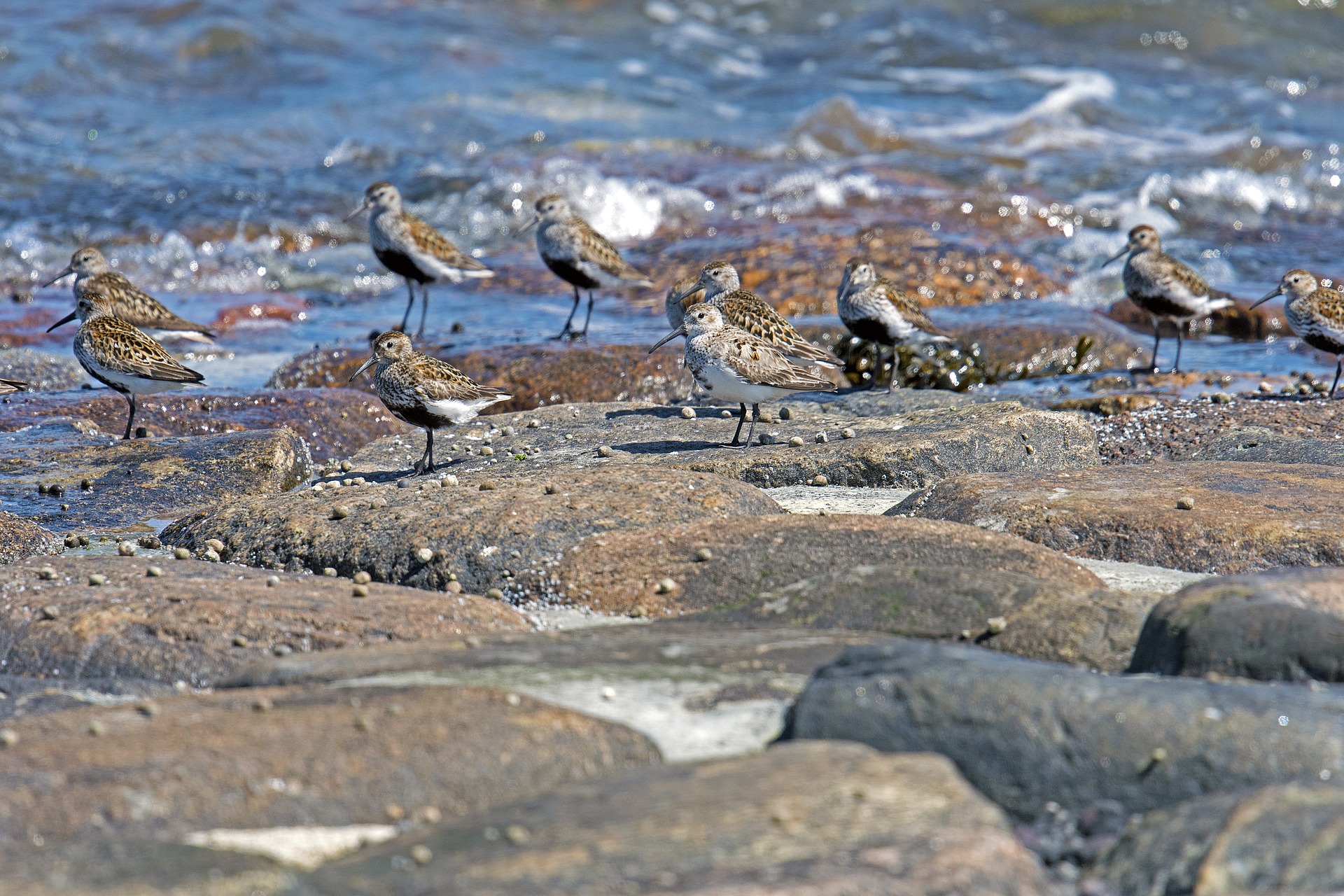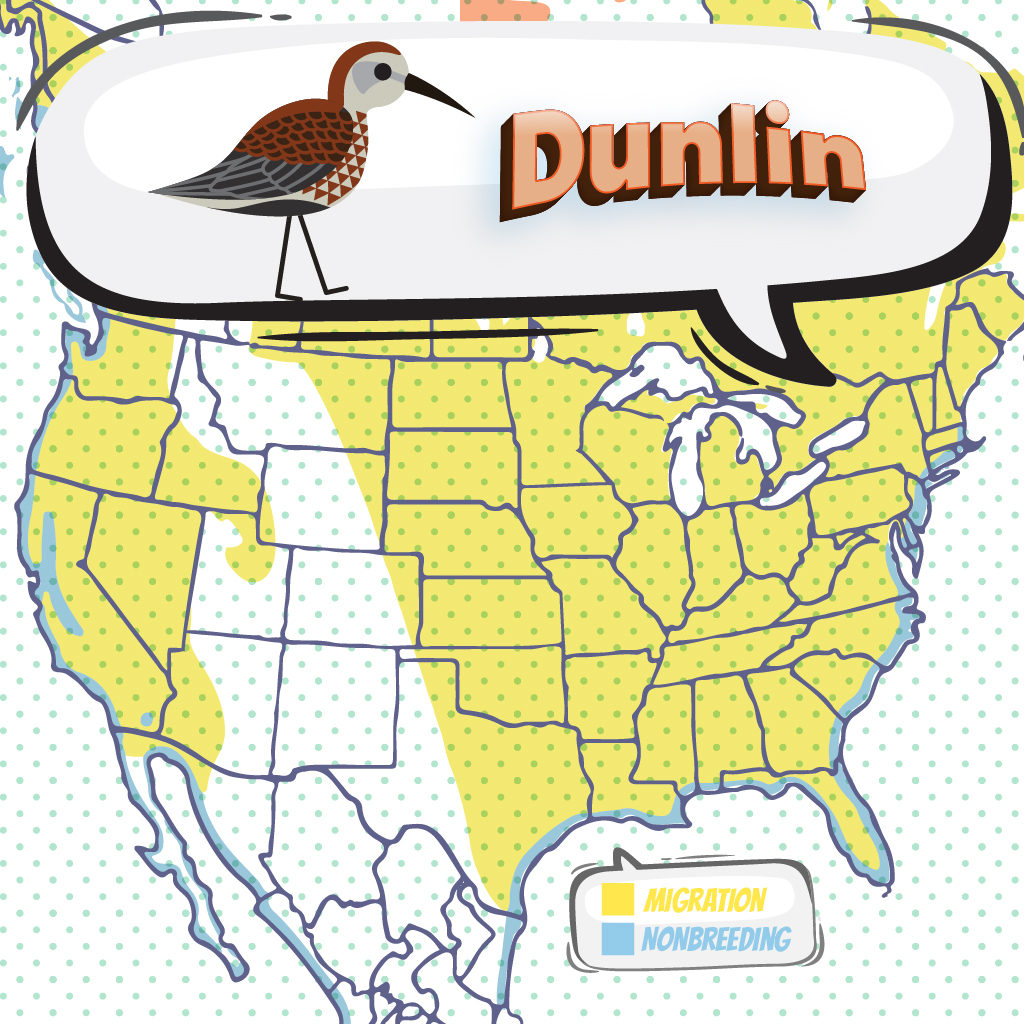
The Dunlin
A Dunlin is a fun bird to see while bird watching. Below are some tips to help you identify Dunlins. We have also put together a list of fun Dunlin t-shirts, Dunlin bird patches, bird houses, bird feeders, binoculars, stickers and other fun bird watching items.
About Dunlins
Their name simply means “little-dun colored bird”. They spend much of their time farther north in the winter compared to their relatives. They can be found on northern beaches of New England and southern Alaska and breed in northern North America and Eurasia. The oldest Dublin was approximately 12 years and 5 months. Some of their distinctive features include:
Description and Identification
Juveniles, breeding, and non-breeding adults all display distinct physical features that characterize them. The breeding adults have bright rust-colored crowns and backs with conspicuous black bellies. Their underparts also have black patches. The non-breeding adults have grayish-white and brown bodies with white undersides. Juveniles tend to be brown with scaly black and brown marbled patterns above. They have two whitish V-shaped marks on their backs and show strong white wing-bars during flights. They are also usually observed to have black marks on their bellies or flanks. All dunlins have black legs and black, decurved bills. These birds tend to be between 6 – 8 inches in length with a wingspan of around 12 – 14 inches. There is slight sexual dimorphism observable among the dunlins, wherein the females are slightly longer billed than the males.
Dunlin Color Pattern
The breeding adults have black underparts and rusty mottled upperparts while nonbreeding adults have gray-brown underparts and brownish upperparts. Juveniles have brown-black smear underparts and reddish upperparts with scaly edges. They all have black legs.
Dunlin Size
They have slightly longer legs, long dropping bill and appear to have a hunched appearance.
The relative size of both sexes
- Length span: 6.3-8.7 in (16-22 cm)
- Weight: 1.7-2.3 oz (48-64 g)
- Wingspan range: 14.2-15.0 in (36-38 cm)

Dunlin Behavior
Dunlins forage by picking items or prey on the surface or by probing in the mud. They do this in quick successions, several times per second. They forage both during the night and day. When defending their territory, the males raise one wing and advance towards the intruder or by circling around the territory while singing.
Dunlin Food
Dunlins mostly eat invertebrates that are found in soil, sand, and mud. They forage and find organisms with their sensitive bills, detecting their prey by touch. The insects that they consume include earthworms, marine worms, midges, flies, craneflies, spiders, beetles, snails, blue mussels, small clams, and amphipods. They also consume small amounts of plant matter, mostly seeds, and grains. On rare occasions, dunlins are known to eat fish as well.
They mostly feed on insects in the tundra and numerous invertebrates along the coastline. Their diet changes with seasons and also with the location. Along the coast, they feed on small creatures such as snails, marine worms, small fish, amphipods, and mollusks. They can as well feed on seeds and leaves.
Dunlin Habitat
Dunlins nest in the subarctic and arctic regions of the tundra. They are usually found in wet areas with slight ridges and ponds at the edges of marshes, hammocks, and coastal lagoons. In winter, large flocks roost and forage through saltwater bodies like estuaries and lagoons or in wet or flooded farm fields. At high tides, they gather on beaches, islands, or at the upper edges of marshes. During migration, they stop by agricultural fields, muddy edges of farm ponds, rivers, lakes, and sewage treatment ponds. Due to the grand geographical scales at which the dunlins migrate, they can be found in most continents along with coastal or wet areas when observed according to the seasons. It should be noted, however, that they opt for areas with 2 inches of water or less for nesting.
During the breeding season, they can be found on the moist and boggy tundra. They also frequent wet coastal grasslands and wet upland moorlands. Outside the breeding season, they are a common sight in lagoons, muddy shores, sandy coasts, and flooded fields.
Range and Migration

Dunlins are small migratory birds that nest around the Arctic regions of the Northern Hemisphere. During non-breeding seasons, they can be found along the coasts of the Atlantic and Pacific oceans. The birds that breed in Northern Europe and Asia tend to be long-distant migrants that winter in the Middle East, Africa, and South-East Asia. On the other hand, birds that breed in Alaska and the Canadian Arctic tend to be short-distant migrants flying towards the Pacific and Atlantic coasts of North America during winters, though there are instances of some flocks flying towards Asia instead.
Dunlin Lifecycle
The females lay 3-4 eggs and incubation is carried out by both parents. The male incubates during the day while the female incubates during the night. Incubation lasts for 20-24 days. Both parents feed the young ones for the first few days. Later, they feed themselves and fledge after 19-21 days. They have a lifespan of close to 5 years in the wild.
Nesting
The males play an active role in the nesting process by selecting an area that will have the nest, usually in tundra vegetation near clumps of grass. Both the sexes contribute to making scrapes for the nest. The scrapes – depressions in the vegetation – are then lined with leaves, sedges, and grasses. The females are the ones that decide the actual nesting site at the end of the process. The incubation period lasts for 20 – 22 days with a clutch having 3 – 4 eggs.
Ornithology
Bird Watching Academy & Camp Subscription Boxes
At Bird Watching Academy & Camp we help kids, youth, and adults get excited and involved in bird watching. We have several monthly subscription boxes that you can subscribe to. Our monthly subscription boxes help kids, youth, and adults learn about birds, bird watching, and bird conservation.
- Kids Bird Watching Monthly Subscription$10.00 / month
- Kid & Adult Bird Watching Starter Pack Subscription$10.00 / month and a $72.00 sign-up fee
- Kids Bird Watching Starter Pack Subscription$10.00 / month and a $19.00 sign-up fee
Bird Watching Binoculars for Identifying Dunlins
The most common types of bird watching binoculars for viewing Dunlins are 8×21 binoculars and 10×42 binoculars. Bird Watching Academy & Camp sells really nice 8×21 binoculars and 10×42 binoculars. You can view and purchase them here.
- Birding Binoculars$49.99
- Kids Binoculars$13.99
Dunlin T-shirts
If you love the Dunlin you should purchase a Bird Watching Academy & Camp T-shirt. To help support bird conservation we donate 10 percent to bird conservation activities.
Dunlin Iron On Patches
Kids, Youth, and Adults love to collect our Bird Watching Academy & Camp iron-on patches. Our bird-watching patches help you keep track of the birds you have seen and identified. You can also display the patches on our Bird Watching Academy & Camp banners.
The Dunlin is a great iron-on patch to start your collection with. The patches are durable and can be sewn on or ironed on to just about anything.
Dunlin Stickers
Stickers are a great way for you to display your love for bird watching and the Dunlin. We sell a monthly subscription sticker pack. The sticker packs have 12 bird stickers. These sticker packs will help your kids learn new birds every month.
Bird Feeders for Dunlin
There are many types of bird feeders. Here are our favorite bird feeders for your backyard. We use all of these bird feeders currently. Kids will have a great time watching birds eat at these bird feeders. Using this collection of bird feeders will provide a wide variety and many types of birds.
Best Bird Houses for Dunlin
There are many types of bird houses. Building a bird house is always fun but can be frustrating. These 4 bird houses have become our favorites. Getting a bird house for kids to watch birds grow is always fun. We spent a little extra money on these bird houses but they have been worth the higher price and look great.









